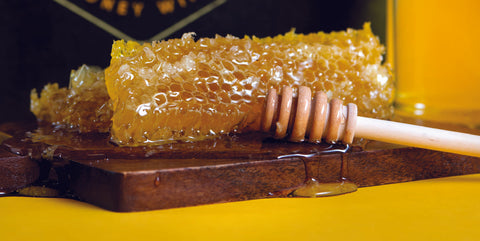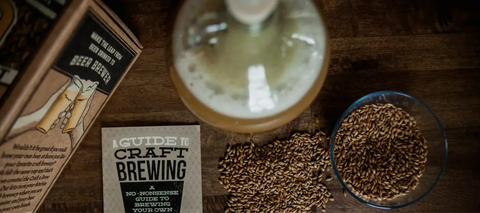TL;DR: Choosing the best honey for making mead involves selecting honey types that match your desired flavor. Opt for wildflower honey for versatility, orange blossom honey for fruity notes, and mango blossom for tropical meads. Consider honey's flavor, color, and sweetness level, and experiment with various types to perfect your mead style. Use raw, high-quality honey for the richest flavors and best fermentation results.
Your Guide to Choosing the Right Honey for Mead
Mead, often referred to as honey wine, is an ancient beverage made by fermenting honey with water. Choosing the right honey for mead is essential because it forms the foundation of your homemade honey wine. The quality and type of honey you select significantly influence the taste, aroma, and overall character of your mead. Crafting exceptional mead begins with choosing honey for mead that complements your desired style and flavor profile. Craft a Brew’s “Mead Maker’s Choice” collection offers a curated selection of the best mead making honey, ensuring your homemade mead is rich in flavor and quality.
Choosing the best honey for making mead involves selecting from various honey types that match your flavor goals. The best honey for mead making will vary depending on what flavor and aroma profiles you’re looking for. Try wildflower honey for mead with a floral and complex profile or orange blossom honey for citrus notes. When choosing honey for mead, keep in mind that your finished honey wine won’t be as sweet as the nectar you start with, so it is advised to ferment and backsweeten, using the same variety or two different types of honey for mead that is complex and sweet in your glass. It’s important to use the best honey for mead making because it’s the foundation of your honey wine!
Honey for mead making comes in numerous varieties, each with distinct flavors, aromas, and colors. Whether you prefer a light and delicate mead or a robust, full-bodied drink, the right honey selection for mead will help you achieve your goal. Let’s explore various honey varieties for mead and how to choose the best honey for your mead-making endeavors in this comprehensive mead honey guide.
Types of Honey for Mead
There are numerous types of honey for mead, each offering unique characteristics that influence your final product. Understanding these honey varieties for mead is crucial in selecting the best honey for mead making. Some honey Our Mead Maker’s Choice collection features premium, raw honey in perfect portions for 1-gallon batches, including classic and rare types. Here are some popular honey varieties that we suggest for making exceptional mead:
Wildflower Honey
Flavor Profile & Characteristics:
- Wildflower honey is collected from various nectar sources and boasts a relatively neutral, yet floral flavor profile.
Tips for using Wildflower Honey for Mead Making:
- Wildflower honey is one of the most flexible and versatile honey varieties for mead. It’s well suited for a wide range of mead styles, from traditional to spiced meads.
- With that said, Wildflower honey flavor will vary depending on the region from where it is harvested. A southeastern wildflower honey from Florida will vary greatly from a Northwestern wildflower honey from Oregon. Buy honey on your travels to make a mead that represents the wildflowers from the area.
Mead Maker’s Choice Wildflower honey is available in a 40 oz (2.5 lb) easy squeeze pouch – the perfect amount of honey for a 1 gallon batch of mead.
Orange Blossom Honey
Flavor profile and characteristics:
- Orange blossom honey offers a distinct citrus aroma with sweet, floral undertones. Zesty, juicy and floral character shines through in the finished mead, especially when Orange Blossom Honey is used for backsweetening.
Tips for using Orange Blossom Honey for Mead Making:
- Orange Blossom Honey is perfect for making refreshing, aromatic meads, especially when aiming for lighter, fruit-forward beverages.
- This honey style is excellent for making melomels (fruited meads), because the citrusy character adds even more fruit character.
Mead Maker’s Choice Orange Blossom honey is available in a 40 oz (2.5 lb) easy squeeze pouch – the perfect amount of honey for a 1 gallon batch of mead.
Christmas Berry Honey
Flavor profile and characteristics
- Harvested from Hawaiian Christmas Berry (Wilelaiki) blossoms, this honey is bright golden yellow and slower to crystallize. Christmas Berry Honey has a nice fruit flavor and an herbal, slightly spiced aftertaste. Some have described it as having a butterscotch-like flavor.
Tips for using Christmas Berry Honey for Mead Making:
- This honey’s unique sweet & confectionary tasting notes makes it perfect for a batch of holiday mead or spiced mead! Consider adding mulling spices or caramelizing the honey before fermentation to make a “bochet” (carmelized honey mead).
Mead Maker’s Choice Christmas Berry honey is available in a 40 oz (2.5 lb) easy squeeze pouch – the perfect amount of honey for a 1 gallon batch of mead.
Mango Blossom Honey
Flavor profile and characteristics:
- Mango blossom honey features a tropical, fruity profile with a smooth, mellow sweetness.
- Because it’s harvested from the nectar of blooming mango trees, this honey possesses tropical fruit and floral notes.
Tips for using Mango Blossom Honey for Mead Making:
- This honey is excellent for crafting exotic, tropical-inspired meads, often enjoyed semi-sweet or sweet.
- Try making a mango melomel (fruited mead), with diced mango chunks!
Mead Maker’s Choice Mango Blossom honey is available in a 40 oz (2.5 lb) easy squeeze pouch – the perfect amount of honey for a 1 gallon batch of mead.
Hawaiian Flower Honey
Flavor profile and characteristics:
- Hawaiian wildflower honey, sourced from diverse flowers across Hawaii, offers a complex, exotic flavor profile. It often includes notes of tropical fruit, hibiscus, plumeria and even subtle earthiness, perfect for creating unique, aromatic meads.
Tips for using Hawaiian Wildflower Honey for Mead Making:
- Take inspiration from the source and make a Hawaiian mead with hibiscus flowers, tropical fruit or even ginger.
Mead Maker’s Choice Hawaiian Wildflower honey is available in a 40 oz (2.5 lb) easy squeeze pouch – the perfect amount of honey for a 1 gallon batch of mead.
Factors to Consider When Choosing Honey
You can use ANY honey to make mead at home! Just make sure that it is 100% honey. Raw, natural honey is best, whether you find it at the grocery store or the farmers market. When choosing the particular style of honey for mead, consider several key factors to ensure you select the best honey for mead that fits your tastes.
Flavor and Aroma
- Honey's flavor and aroma significantly influence your mead’s character. For instance, relatively neutral honeys like wildflower allow you to layer in flavor with added fruit or spices. Meanwhile a citrusy honey like an orange blossom honey, will contribute bright, fresh notes that can carry a mead on its own without added flavor.
- To achieve the flavor and aroma you desire, sometimes it’s a good idea to blend 2 or more honey varieties. For example, Buckwheat honey is extremely dark, bold and even a little funky.” So it might be too overwhelming to use for a mead on its own, but can be blended with another lighter honey to achieve better balance.
Color and Clarity
- Honey color affects your mead’s appearance, ranging from light, straw-colored meads made with clover honey to darker, amber-colored meads from richer honeys like mango blossom.
- It’s often said that we drink with our eyes, so choosing a honey with a beautiful color can enhance the final product!
Sweetness Level
- Different honeys have varying sugar content and sweetness levels, impacting fermentation and final taste. High sugar content honeys can result in higher alcohol content, while less sweet honeys produce lighter, drier meads. Choose according to your desired sweetness and alcohol level.
Understanding these factors helps in choosing the best honey for mead, ensuring a successful and satisfying mead-making experience.
Tips for Using Honey in Mead Making
When choosing honey for mead making, it’s important to consider the appropriate volume and the best variety that’s best suited for the type of mead you want to make:
- Session Meads (Low-alcohol meads): A session mead refers to a mead that is lower in alcohol, meaning you can enjoy more glasses in a session without getting too buzzed. Any variety of honey is well-suited for a session mead, you’ll just need to use less honey per gallon. Less sugar = less alcohol content. We suggest using 24 oz of honey per gallon to make a session mead. Honey varieties for mead like Clover or Orange Blossom are ideal, offering delicate, subtle flavors for a finished mead that is refreshing.
- Standard Meads: Just about any honey will make an excellent standard alcohol content mead. You’ll need 2.5 lb of honey per gallon. For a classic, traditional mead, try wildflower honey! Its balanced floral profile provides complexity without excessive sweetness. Don’t be afraid to blend multiple types of honey in a standard mead for a more complex flavor - like Mango Blossom and Orange Blossom.
- Sack Meads (High-alcohol meads): Rich, bold honey selections like Christmas Berry honey, with its butterscotch-like notes, are perfect for high alcohol meads. Generally, a sack mead will require about 4 lb or more of honey per gallon.
- Melomels (Fruited meads): A mead made with fruit is called a melomel. We like using fruity, floral honeys to complement the fruit flavor. For instance, try an Orange Blossom Honey base with strawberries, or a Mango Blossom Honey base with added pineapple chunks for a tropical mead.
- Cysers (Apple Meads): A mead made with apples is called a Cyser. We love using Orange Blossom Honey for a Cyser because of the natural floral quality and zesty flavor that helps enhance the sweet-tart apple flavors.
- Sweet Meads: A mead can be made sweeter by “backsweetening” with additional honey. You can backsweeten with the same variety you used to make the mead OR you can backsweeten with a different honey for layered flavor! Because a lot of the sweetness and flavor from honey will ferment and dry out, try fermenting with a simple honey and backsweetening with a more complex, flavorful honey. Example: ferment a wildflower honey mead and backsweeten with Christmas Berry honey!
Don't be afraid to experiment with different types of honey for mead. Blending two honey varieties can create unique and complex meads that highlight the best qualities of each honey selection.
Frequently Asked Questions About Honey for Mead Making
When learning how to choose honey for mead, many questions naturally arise about selecting the right honey and its effects on mead quality. Here are common FAQs and honey recommendations for mead to help you craft the perfect batch:
What is the best honey for making mead?
The best honey for making mead depends on your flavor preference. Lighter honeys, like clover or orange blossom, suit subtle or dry meads, while darker honeys like buckwheat or Christmas berry are ideal for bold, rich meads.
What type of honey should I use for mead?
You can use nearly any type of honey, but raw, unprocessed, natural honey is recommended for its rich, complex flavors and fermentation-friendly properties.
Does honey quality affect mead?
Absolutely! Honey quality significantly impacts your mead's flavor, aroma, clarity, and overall character. Always opt for high-quality, raw honey for superior results.
How does honey affect the fermentation process?
Honey’s sweetness level and composition influence fermentation speed and the final sweetness of your mead. Higher sugar content can lead to stronger meads and longer fermentation times.
Should I use local or exotic honey for my mead?
Local honey ensures freshness, supports local beekeepers, and can reduce allergies, while exotic honey varieties offer unique and exciting flavor profiles.
Can I mix different types of honey?
Yes! Blending honey types can create complex and layered flavors, making your mead more distinctive and personalized.
Conclusion
Choosing honey for mead is an exciting step that greatly influences your final brew. By understanding what type of honey you should use for mead, you can tailor your honey wine’s flavor, aroma, and sweetness to match your preferences. Remember these key points when selecting honey for your mead:
- ANY honey can be used to make mead! As long as you use 100% natural honey, you’ll make a pretty tasty mead. You can use affordable honey from the grocery store, honey from a local farm, or Mead Maker’s Choice Honey from Craft a Brew.
- Go for quality over quantity. Honey is the foundation of your mead. Its quality impacts your mead’s clarity, fermentation, and overall taste, so always opt for raw, high-quality honey.
- Choose a honey that best suits the type of mead you want to make. Lighter honeys like orange blossom are perfect for delicate flavors in your glass, while darker honeys like Christmas berry offer richer notes.
- When in doubt, blend! You can blend affordable honey with more expensive honey or ferment with one type of honey and backsweeten with something more special or rare.
Embrace the adventure of crafting homemade mead by experimenting with different honeys, and let each batch become a reflection of your creativity and taste. Happy mead making!




